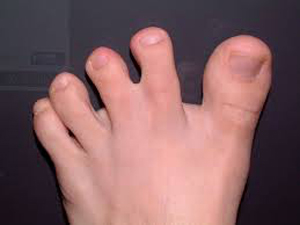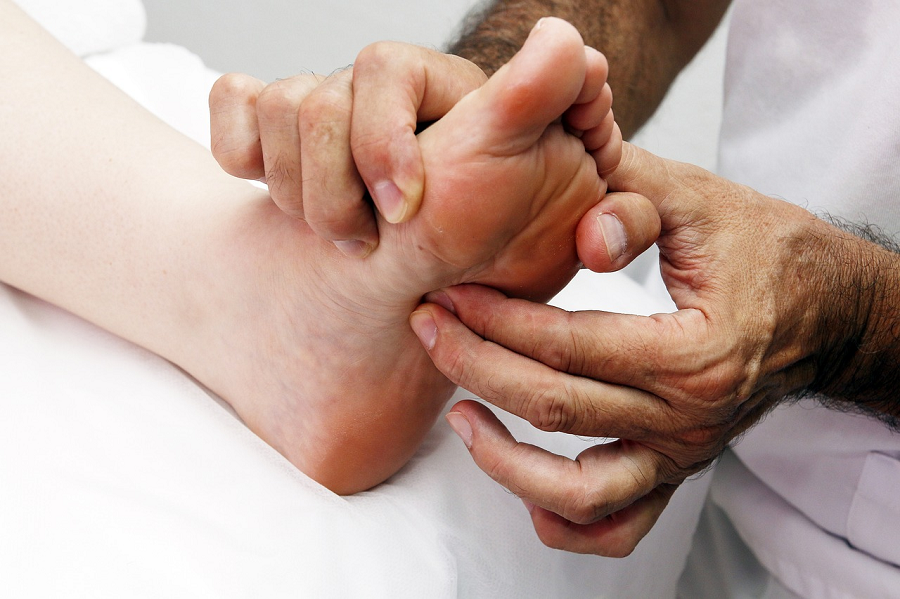Houston’s Top Podiatrist, Dr. Sherman Nagler on the Causes of Webbed Toes?

Embarrassed about your Webbed Toes? NOT ANYMORE, never be shy again to show off your toes.
July 15, 2020
Working from home during the Pandemic? It’s actually a perfect time to have your Bunion Surgery with Houston Podiatrist Dr. Sherman Nagler
July 15, 2020The exact cause of webbed toes is still unknown. Some used to speculate that it was inherited, since family members often share the condition, but it is also common for only one member of a family to have webbed toes.
Some studies show a pregnant woman’s nutritional intake during early gestation and smoking during pregnancy can also contribute to deformities such as webbed toes. Webbed toes are also associated with rare conditions such as:
- Down syndrome
- Apert’s syndrome
- Poland syndrome
- Holt-Oram syndrome
- Carpenter’s syndrome
- Edward’s syndrome
- Fetal hydantoin effect (using the medication hydantoin during pregnancy)
- Miller syndrome
- Pfeiffer syndrome
- Amniotic Band syndrome, also known as constriction band syndrome
- Smith-Lemli-Opitz syndrome
- Aarskog-Scott syndrome
- Bardet-Beidl syndrome
- Cornelia de Lange syndrome
- Familial syndactyly
- Timothy syndrome
Unfortunately, the list above is not complete. There are over 100 different syndromes that are associated with webbing of the digits. Talk with Dr. Nagler and Staff about the possible conditions that could have caused your webbing.
How Are Webbed Toes Diagnosed?
Diagnosis can take place at birth or it can be done via fetal sonogram before birth. Occasionally additional symptoms appear that indicate the presence of an underlying syndrome.
If symptoms of such a syndrome are present, diagnosis is based on family and medical history and a physical exam.
Can Webbed Toes Be Separated?
Yes, webbed toes can be separated surgically, although this condition does not generally cause any health problems, so surgery is not typically necessary. Still, if you wish to have your toes separated, your doctor will use a skin graft from the thigh area to surgically separate the toes.
Skin grafts allow doctors to fill in the space between the toes. The results for surgical separation of webbed toes depend on the severity of the webbing and on the underlying bone structure. Before the procedure you will be given a general anesthesia.
Dr. Sherman Nagler will then mark the areas of skin that are being repaired, using the marks to cut the skin and lift small flaps at the sides of your toes within the webbing. These flaps are then sutured (stitched) into position.
The gaps are then filled with full-thickness skin grafts, typically taken from the thigh area. Your doctor will then bandage your foot.
The procedure itself can last from two to four hours, and you can expect to stay in the hospital for a day or two after surgery. You may experience some swelling and bruising, but this is common.
Dr. Sherman Nagler will show you the proper way to change your bandages. Skin grafts are susceptible to dryness. Many doctors recommend using moisturizers like Lubriderm or Nivea for dry skin.
Are There Any Complications of Webbed Toes?
Unfortunately, there is some scarring after the surgery, and the webbing occasionally grows back. You may experience post-operative swelling, severe pain, numbness, bluish discoloration, and tingling toes.
If any of these symptoms appear, you should contact your doctor or surgeon immediately. Additional complications that may arise include:
- Skin graft damage, may darken over time
- Breathing problems
- Sore throat from intubation
- Excessive bleeding
- Infection
- Bad reaction to medications
- May need second surgery (depends on type of syndactyly)
Because most skin grafts are taken from the thigh area, the graft may grow hair over time. This issue is purely cosmetic, as the hair can easily be removed with tweezers.
Call Houston’s Foot Doc Sherman Nagler for any questions about webbed feet. 71.529.1010



